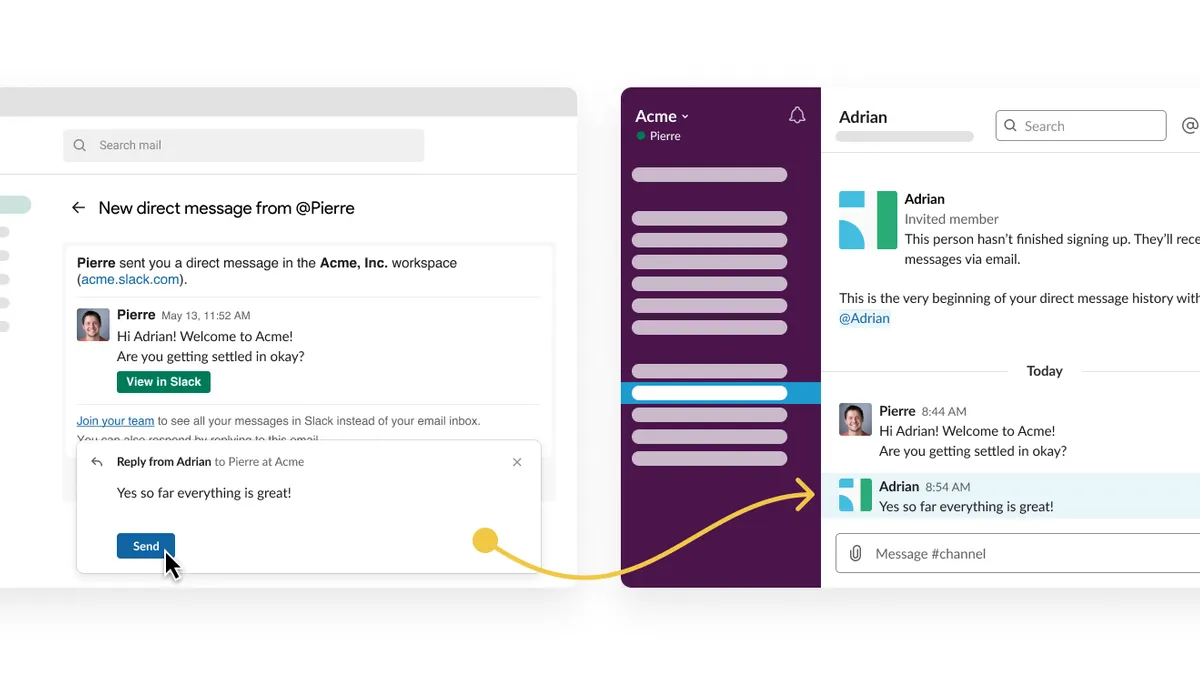Slack dubbed email the cockroach of the internet because it's impossible to kill. Still, the company is aiming to squash it.
The collaboration software company made its debut on the New York Stock Exchange last week, closing Monday with an $18 billion market cap. Ahead of the direct listing, CEO Stewart Butterfield told CNBC when it comes to choosing between email and platforms like Slack, "everyone will choose this."
Butterfield gives email another five to seven years before companies lean more heavily on collaboration software platforms than email. But seven years is an unrealistic expiration date for email.
A chorus of companies have given email a timeline, but deadlines pass, and email is still alive and well.
"To expect email to just go away in less than a decade and businesses to adopt a completely new solution is a bit of a pipe dream," Mike Hicks, CMO at Igloo Software, told CIO Dive.
But Slack's strong public debut indicates the market is ready for its type of communication.
In its early days, Slack was looking for communication functions similar to Facebook's use of the thumbs up and thumbs down clicks, according to Slack CTO and co-founder Cal Henderson, who spoke at The Wall Street Journal's Future of Everything Festival last month.
The visual cues that are now a staple of Slack's functions today automated purely transactional communication. These functions, which email lacks, is where the company can prove its viability in the war against email.
"If Slack is to be successful, Stewart [Butterfield] will almost have to be at least partially right," Michael Facemire, VP, principal analyst at Forrester, in an interview with CIO Dive.
Email's lifeline
Modern enterprises were built on email. From the early days of "You've got mail" and the screeching dial tone, email has been an office communication staple.
Email is, quite frankly, "too ingrained into most employees' work lives for it to just go away," said Hicks. "Even if you’re implying that in seven years, no employee will want to use email — which is far-fetched — then you also need to have businesses completely transform the way they communicate" with everyone inside and outside a single company.
Unlike email, communication on platforms like Slack have been restricted to single user base. Up until recently, Slack users were confined to speaking only with those inside their company.
This year, Slack built bridges between email and its platform so non-Slack users could receive alerts from messages or mentions in their inboxes.
The company also allowed expansion of Slack communication for users outside their immediate organization, opening conversations with customers, vendors, agencies or other Enterprise Grid members.
Even at its best, interaction stops with other Slack users. If a partnered company uses another platform, like Microsoft Teams, communication is likely to fall back on email.
A not-so-clear winner
Slack is attempting to live harmoniously with email through a series of integrations. At the end of the day, email's necessity will long outlive its frustrations (like getting stuck on a companywide email chain).
Neither platform has exterminated distraction. "They both have their sins," said Facemire.
Catching up on conversations on either outlet can be distracting and cost a company hours of productivity.
More than half of baby boomers, 57%, are distracted by email and messaging tools, though only 22% of millennials and Gen Zers feel the same, according to a Udemy survey.
"Employees may feel they need to respond right away unlike email," Cara Brennan Allamano, SVP of HR at Udemy, told CIO Dive. They "struggle with the always-on nature of the tool," which can unintentionally undermine strategic thinking.
Internally, Slack uses a "polite raccoon" to regain employee attention when conversations become derailed, which is easy to do when responses are near instant on collaboration platforms.
Workplace communication will always need boundaries, whether it takes place through email or Slack.
When an email chain resurfaces in an inbox over and over, employees ask to be removed from the thread. Or the fear of judgemental retribution by asking such a thing may make them move the chain to junk.
Slack, on the other hand, can mute a chain's notifications or entirely leave the channel it's taking place.
"In reality, I'm not sure any of us micromanage our individual communications enough to say that is solved," said Facemire. Slack is guilty of stoking the fear of missing out if an employee isn't constantly monitoring the platform.













